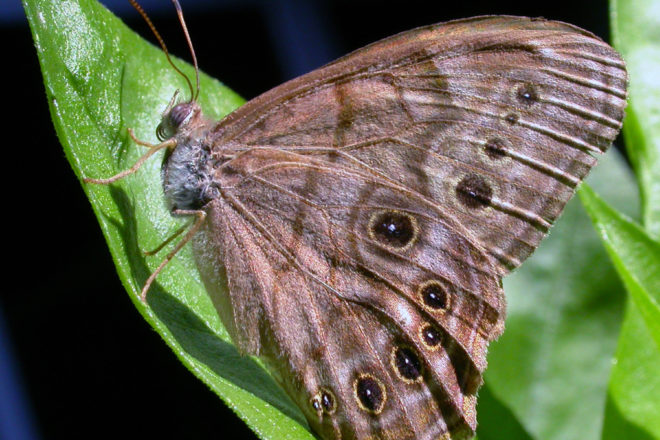Door to Nature: Gentle, Voiceless Creatures
- Share
- Tweet
- Pin
- Share

Few animals are as gentle, harmless, common and beautiful as butterflies. I am finally seeing some of the wood satyrs and northern pearly eyes that live in my woods because they were about two weeks late in emerging.
It is so important to cultivate in youngsters an admiration and respect for butterflies and other small creatures so children can become more appreciative and sensitive adults. These young people will be in charge of the environment in the years ahead. The more they know and care about the natural world, the better future they can cultivate. Why not begin with the basics: the birds, trees, flowers, ferns and butterflies that exist in their own county or yard?
As a starter, here are some common butterflies. Everyone knows the monarch – a strong, leisurely flier, renowned for its long annual migrations. What you may not know is how easy it is to identify their sex. One of the black veins on the underside of each of the male’s hind wings has an enlarged black spot. These are tiny pockets containing scent scales that the male can brush into the air to attract females.
The viceroy is quite similar to the monarch but is about three-quarters of an inch smaller in width and considerably faster in flight. Look carefully to see a black line on the hind wing that runs parallel to the black edge. The monarch lacks this vein.
A close relative to the viceroy is the white admiral: a black butterfly with white bands on its wings. A row of red spots and blue border spots decorate each hind wing. They are exceptionally beautiful fliers and often soar with their wings held horizontally. These classy butterflies are known to favor certain perches and will use them repeatedly. Their weird-looking caterpillars eat the leaves of birch, poplar and willow trees.
My late husband, Roy, and I used to have a patch of stinging nettles growing near our vegetable garden, and Roy would leave them for the larvae of the red admiral butterflies. They have dark-brown bodies with bright-orange wing stripes. Some of these butterflies can survive the winter as adults and surprised us on sunny days during the spring maple syrup season when snow still lingered in the woods.
The painted lady is perhaps the most cosmopolitan of all butterflies. Hollyhock, sunflower, pearly everlasting, burdock and thistle leaves all satisfy the caterpillars’ appetites. These fragile butterflies migrate northward from Mexico each spring.
A big, easily identified butterfly on the wing from mid-June to early September is the great spangled fritillary. It seeks nectar on common milkweed and swamp thistle flowers. Its golden-orange color with black spots makes it a flashy flier. The caterpillars feed on wild violet plants and overwinter.
A large group called the tortoiseshell butterflies includes another great favorite, the mourning cloak. Any butterfly that, as an adult, can crawl into an outdoor woodpile, survive the icy blasts of winter and emerge in the spring to fly on the first 50-degree-plus day has to be considered quite extraordinary. Its deep-brown wings edged with light yellow and tiny, bright-blue dots mark this butterfly well.
A rather small, inconspicuous butterfly of midsummer, the northern pearly eye, could serve as a good example of what Johann Fabricius – a Danish entomologist of the late 18th century – said: “Nature is most to be admired in those works which are least.” The northern pearly eye’s soft-brown color is highlighted with tiny eyespots.
Try to catch one of these butterflies whose flight, usually near the ground, appears to be weak and jerky. You are in for a surprise because suddenly it will dance and bob and weave its way through the shrubs and tall grass, easily escaping your most energetic attempts to capture it.
Try to sharpen your powers of observation to learn more about the native plants that many butterflies prefer and need to absorb. Enjoy new, exciting experiences to feel increasingly that you – along with other creatures large and small – are a genuine partner in nature. And take small children by the hand to lead them into the great outdoors to learn about butterflies. The future is for – and depends on – children.


